Please click here to access the main AHDB website and other sectors.
- Home
- Knowledge library
- Different types of planting material
Different types of planting material
Different plant types can be used in different production systems to extend the cropping season.
Overview
A range of plant material is available to growers, which can be used in different ways to crop at certain times of the season:
- Fresh dug plants
- Graded plants
- Graded cold-stored plants
- Waiting bed plants
- Crown plants
- Tray plants
- Misted tip plants
- Potted everbearers
Fresh dug plants
Fresh dug plants of mainseason varieties are used less today, but they are still used for everbearer varieties that are planted in autumn or spring.
Fresh dug Bolero plants ready for planting
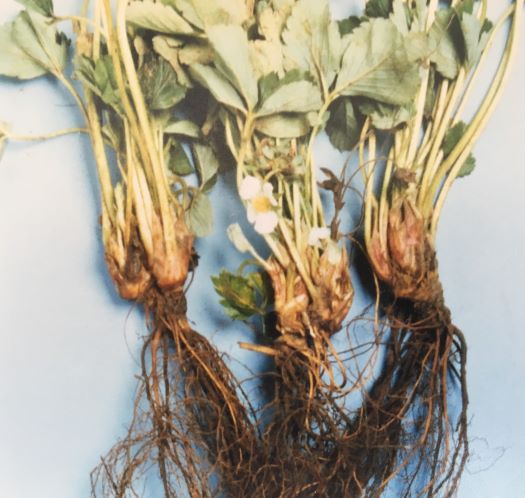
Image © ADAS
They are plants that have been raised in the field and are lifted either between August and November or from February until April.
Traditionally, they were used by mainseason strawberry growers before crop manipulation and spread of season became important.
Field soils
Everbearer varieties are planted straight into field soils for a first-year crop.
With mainseason varieties, the diameter of plant crowns and flower numbers tends to vary, so many growers traditionally removed the blossom in the first year in order to grow a larger plant, taking a first crop in the second growing year.
Graded plants
Varieties such as Elsanta and Sonata can produce plants of variable crown size and when supplied by propagators, are graded by the diameter of the plant’s crown.
Fresh dug Elsanta plants showing variation in crown size
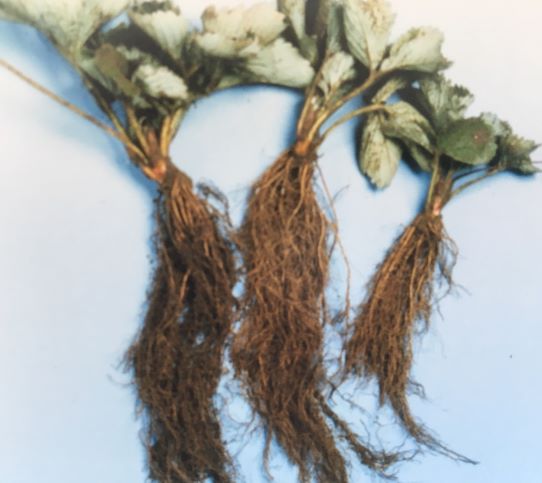
Image © ADAS
In general, the larger the crown diameter, the more flowers are produced and hence the heavier the potential yield.
Conversely, the smaller the crown diameter, the fewer flowers produced and the more variable the performance of the plant.
Grading
Grading and pre-selecting plants allows growers to choose stock with a crown size appropriate to their requirements.
When procuring plants, it is important to choose crowns of similar size to ensure that plants establish evenly.
This also improves the accuracy of yield prediction.
Most plant suppliers grade plants into three size categories.
These may vary from supplier to supplier and from year to year, depending on the weather.
However, plants tend to be classified as:
- A+ Plants (crown diameter of 15 mm or more).
- Premium Grade (crown diameter of between 12–15 mm).
- Small Grade (crown diameter of 12 mm or less).
Graded cold-stored plants
Graded cold-stored plants are produced in field soils, lifted when dormant, graded according to crown size and held in cold storage at -1.6°C until they are required by growers for planting.
The larger crown sizes tend to have greater starch reserves and can be stored for longer, allowing them to be planted later for later cropping.
This makes them ideal for use in 60-day cropping programmes with varieties such as Elsanta and Sonata.
However, older plants do not store as well as younger ones and this must be taken into account when organising planting strategies.
Larger crown sizes
Some mainseason varieties produce larger crown sizes than others. Elsanta and Sonata can produce a crown of 24 mm in diameter and so have a high yield potential in a 60-day crop.
Other varieties, however, have smaller crowns and are less well suited to this type of production.
Waiting bed plants
Waiting bed plants are bare root plants that have been grown on to produce crowns with a diameter of more than 18 mm.
Waiting bed plants with a diameter of greater than 18 mm displaying sub-crowns
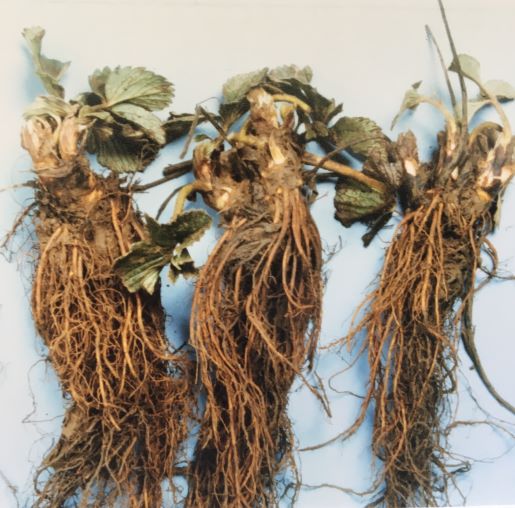
Image © ADAS
Elsanta and Sonata have the ability to produce large crowns and are well suited to this type of production.
The current type of waiting bed plants used are known as true waiting bed plants.
True waiting bed plants are produced by growing fresh dug plants (that have been lifted by early August), in a waiting bed where they have their runners removed and are fed and watered.
Lifting
By the end of the growing season, plant size has increased considerably.
Plants are finally lifted when dormant and held in cold storage until required.
The plants are graded by size, eg Medium (18–22 mm) and Heavy (22+ mm), but propagators will normally expect to discuss more precise plant size and truss number requirements with their customers prior to purchase.
Crown plants
Crown plants are bare root mother plants harvested from propagation fields in the dormant season.
Crown plants – note the characteristic root volume
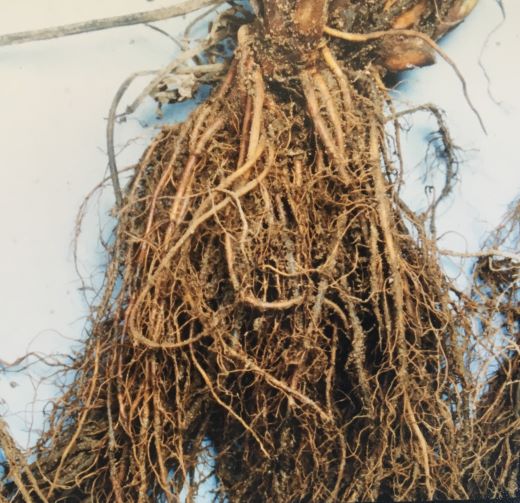
Tray plants
Tray plants are propagated in trays rather than in field soils.
Runners produced from mother plants are rooted into modular trays (often under glass or polythene) and grown on.
They are removed from their trays in the dormant season and held in cold storage until sale.
Tray plants removed from their trays and ready for planting
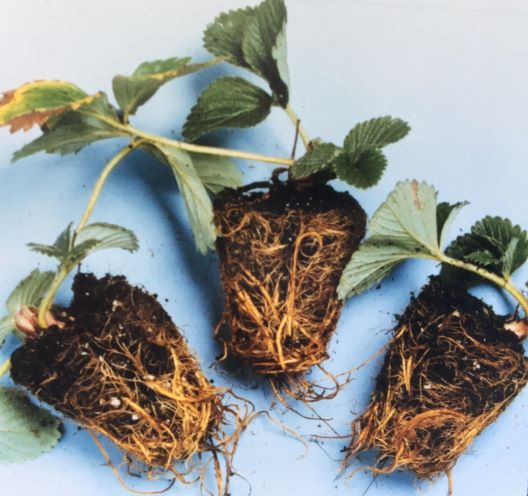
Image © ADAS
Their well-developed roots enable them to become more evenly established than bare rooted plants whilst also allowing them to be stored over longer periods.
Glasshouses
Tray plants are very useful for 60-day cropping in both spring for early production or autumn for late production.
They are particularly suited to glasshouses as they produce fruit of high quality, cope better with long term cold storage (December-July) and likely high temperatures experienced after planting under glass in July-August.
Some recently introduced everbearer varieties that show eating quality comparable with popular short-day varieties may be propagated to provide tray plant material in order to provide significant quantities of fruit in May-June.
Misted tip plants
Misted tip plants are also produced in peat modules or pots. Mainseason varieties are sometimes produced in this way.
Misted tip Florence plants ready for planting
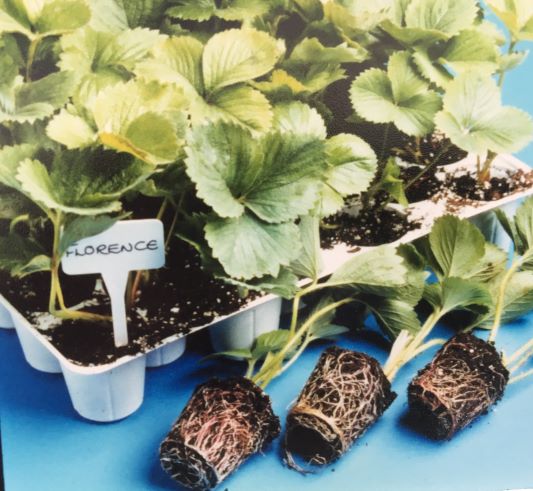
Image © ADAS
Runner tips are harvested from mother plants in early July and rooted in a module or pot using overhead misting to produce a well rooted plant that is available for planting from mid-July onwards.
The establishment of such plants in mid-summer (typically after July but before mid-August) in their final rooting position allows them to develop a large plant with a high-yield potential for cropping the following year.
Although they do not produce an instant yield like a 60-day plant, if established by the end of July, misted tip plants often produce higher yields in the first main cropping season than equivalent crops established from waiting bed or tray plants.
The fruit is often earlier and better presented too.
Such a system is an ideal choice for varieties that are less capable than Elsanta or Sonata of producing large-crowned plants for 60-day cropping.
There is also increasing interest in producing everbearer varieties using this technique.
The runner tips would be harvested in late summer to produce an autumn rooted plant for spring planting.
Potted everbearers
Potted everbearers are produced by lifting bare root everbearer plants from propagation beds in late autumn or winter, potting them into modular trays or pots then growing them on under glass or polythene.
This technique produces a larger plant with more developed roots that, if managed well, can establish more quickly and offer an earlier start and a higher yield potential than everbearer plantations established conventionally using fresh dug or cold-stored plants.
It has therefore become popular among many growers who prefer to establish everbearer plantations in the spring.
Original authors
Scott Raffle, AHDB, Robert Irving, ADAS and Graham Moore, FAST Ltd

